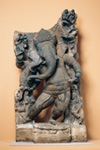|
Ganesha |
||
 India,
Uttar Pradesh India,
Uttar Pradesh 8th century Sandstone H. 49 1/2 in. (125.7 cm); 1979.13 |
||
|
Artist Comments |
||
|
One can only marvel at the understanding of anatomy, the visceral sense of movement and rhythm, and the choreographic skill of the artist who produced this performance in stone. This multi-armed, squat little figure with dimpled paunch, thick legs, sensitive hands and feet, has the head of an elephant. He is in fact a dancing elephant, presaging Walt Disney's Fantasia by roughly twelve hundred years. Ganesha is caught in an ecstatic off- centered swirl of movement. Yet there is nothing frantic or out of control here. The alert attentiveness of his large ears make palpable his celestial accompaniment. The elegant placement of his many hands-all performing effortlessly complex mudras-are in sophisticated counterpoint to the graceful rhythm of his belt and swaying trunk. This is a suave
and elegant dancer who throws out his left hip with sensual-I dare
say sexy-finesse while observing us with aloof tiny eyes, as if
to say, "Jump on in! Let's see what you can do! I dare you."
It is said that sitting on a riverbank a great sage dictated a poem to Ganesha. The sage's recitation continued for nights and days without pause until all Ganesha's pens had worn away. Rather than interrupt the flow of the sage's inspiration, the elephant-headed god broke off one of his tusks, dipped it into ink, and carried on writing. With his sacrifice Ganesha ensured that mankind would possess the longest-and to Indians, the greatest-epic poem in human history, the Mahabharata. |